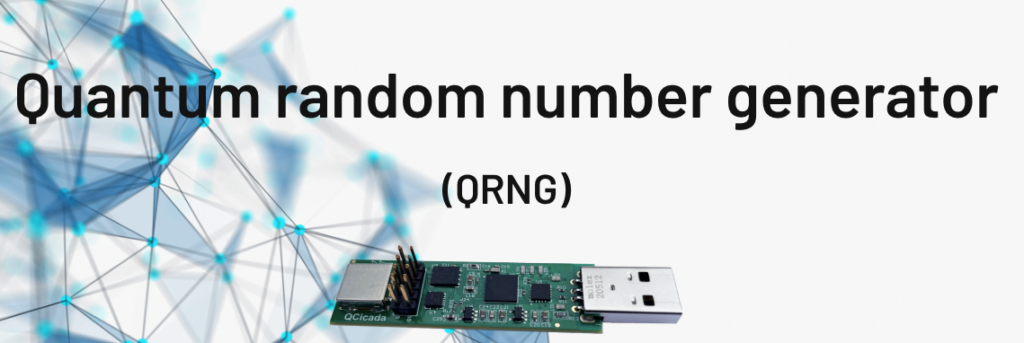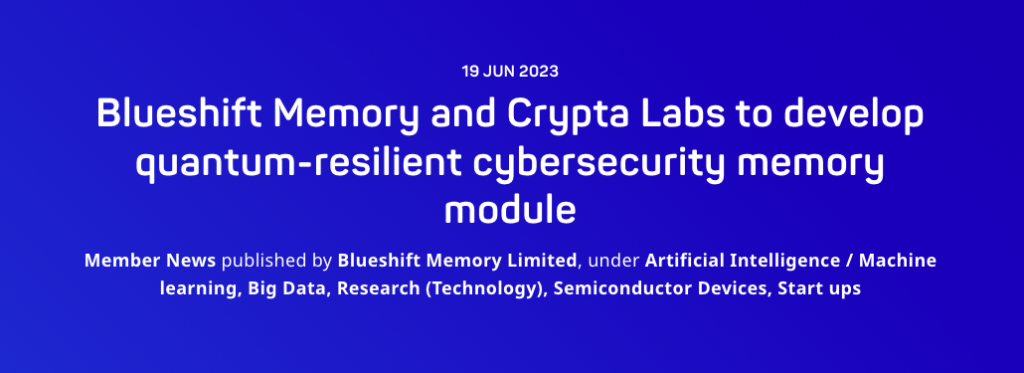The future of AI compute is photonics… or is it?
Exploring the potential of photonics to improve efficiency in the future of compute
Random numbers are used everywhere, from facilitating lotteries, to simulating the weather or behaviour of materials, and ensuring secure data exchange between infrastructure and vehicles in intelligent transport systems (C-ITS).
Perhaps most importantly though, randomness is at the core of the security we all rely upon for transacting safely on the internet. Specifically, random numbers are used in the creation of secure cryptographic keys for encrypting data to safeguard its confidentiality, integrity and authenticity.
Random numbers are provided via random number generators (RNGs) that utilise a source of entropy (randomness) and an algorithm to generate random numbers. A number of RNG types exist based on the method of implementation (e.g. hardware and/or software).
Pseudo-random number generators (PRNGs)
PRNGs that rely purely on software can be cost-effective, but are intrinsically deterministic and given the same seed will produce the exact same sequence of random numbers (and due to memory constraints, this sequence will eventually repeat) – whilst the output of the PRNG may be statistically random, its behaviour is entirely predictable.
An attacker able to guess which PRNG is being used can deduce its state by observing the output sequence and thereby predict each random number – and this can be as small as 624 observations in the case of common PRNGs such as the Mersenne Twister MT19937. Moreover, an unfortunate choice of seed can lead to a short cycle length before the number sequence repeats which again opens the PRNG to attack. In short, PRNGs are inherently vulnerable and far from ideal for cryptography.
True random number generators (TRNGs)
TRNGs extract randomness (entropy) from a physical source and use this to generate a sequence of random numbers that in theory are highly unpredictable. Certainly they address many of the shortcomings of PRNGs, but they’re not perfect either.
In many TRNGs, the entropy source is based on thermal or electrical noise, or jitter in an oscillator, any of which can be manipulated by an attacker able to control the environment in which the TRNG is operating (e.g., temperature, EMF noise or voltage modulation).
Given the need to sample the entropy source, a TRNG can be slow in operation, and fundamentally limited by the nature of the entropy pool – a poorly designed implementation or choice of entropy can result in the entropy pool quickly becoming exhausted. In such a scenario, the TRNG has the choice of either reducing the amount of entropy used for generating each random number (compromising security) or scaling back the number of random numbers it generates.
Either situation could result in the same or similar random numbers being output until the entropy pool is replenished – a serious vulnerability that can be addressed through in-built health checks, but with the risk that output is ceased hence opening the TRNG up to denial-of-service attacks. Ring-oscillator based TRNGs, for instance, have a hard limit in how fast they can be run, and if more entropy is sought by combining a few in parallel they can produce similar outputs hence undermining their usefulness.
IoT devices in particular often have difficulty gathering sufficient entropy during initialisation to generate strong cryptographic keys given the lack of entropy sources in these simple devices, hence can be forced to use hard-coded keys, or seed the RNG from unique (but easy to guess) identifiers such as the device’s MAC address, both of which seriously undermines security robustness.

Ideally, RNGs need an entropy source that is completely unpredictable and chaotic, not influenced by external environmental factors, able to provide random bits in abundance to service a large volume of requests and facilitate stronger keys, and service these requests quickly and at high volume.
Quantum random number generators (QRNGs)

QRNGs are a special class of RNG that utilise Heisenberg’s Uncertainty Principle (an inability to know the position and speed of a photon or electron with perfect accuracy) to provide a pure source of entropy and therefore address all the aforementioned requirements.
Not only do they provide a provably random entropy source based on the laws of physics, QRNGs are also intrinsically high entropy hence able to deliver truly random bit sequences and at high speed thereby enabling QRNGs to run much faster than other TRNGs, and more efficiently than PRNGs across high volume applications.
They are also more resistant to environmental factors, and thereby at less risk from external manipulation, whilst also being able to operate reliably in EMF noisy environments such as data centres for serving random numbers to thousands of servers realtime.
But not all QRNGs are created equal; poor design in the physical construction and/or processing circuitry can compromise randomness or reduce the level of entropy resulting in system failure at high volumes. QRNG designs embracing sophisticated silicon photonics in an attempt to create high entropy sources can become cost prohibitive in comparison to established RNGs, whilst other designs often have size and heat constraints.
Introducing Crypta Labs
Careful design and robustness in implementation is therefore vital – Crypta Labs have been pioneering in quantum technology since 2014 and through their research have developed a unique solution utilising readily available components that makes use of quantum photonics as a source of entropy to produce a state-of-the-art QRNG capable of delivering quantum random numbers at very high speeds and easily integrated into existing systems. Blueshift Memory is an early adopter of the technology, creating a cybersecurity memory solution that will be capable of countering threats from quantum computing.

Rapid advances in compute power are undermining traditional cryptographic approaches and exploiting any weakness; even a slight imperfection in the random number generation can be catastrophic. Migrating to QRNGs reduces this threat and provides resiliency against advances in classical compute and the introduction of basic quantum computers expected over the next few years. In time, quantum computers will advance sufficiently to break the encryption algorithms themselves, but such computers will require tens of millions of physical qubits and therefore are unlikely to materialise for another 10 years or more.
Post-quantum cryptography (PQC) algorithms
In preparation for this quantum future, an activity spearheaded by NIST in the US with input from academia and the private sector (e.g., IBM, ARM, NXP, Infineon) is developing a set of PQC algorithms that will be safe against this threat. A component part of ensuring these PQC algorithms are quantum-safe involves moving to much larger key sizes, hence a dependency on QRNGs able to deliver sufficiently high entropy at scale.
In summary, a transition by hardware manufacturers (servers, firewalls, routers etc.) to incorporate QRNGs at the board level addresses the shortcomings of existing RNGs whilst also providing quantum resilience for the coming decade. Not only are they being adopted by large corporates such as Alibaba, they also form a component part of the White House’s strategy to combat the quantum threat in the US.
Given that QRNGs are superior to other TRNGs, can contribute to future-proofing cryptography for the next decade, and are now cost effective and easy to implement in the case of Crypta Lab’s solution, they really are a no-brainer.

Exploring the potential of photonics to improve efficiency in the future of compute

Exploring more esoteric approaches to the future of compute